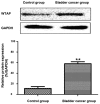Relationship between the genetic expression of WTAP and bladder cancer and patient prognosis
- PMID: 30546429
- PMCID: PMC6256415
- DOI: 10.3892/ol.2018.9554
Relationship between the genetic expression of WTAP and bladder cancer and patient prognosis
Abstract
The relationship between the gene expression of Wilms tumor 1-associated protein (WTAP) and bladder cancer was investigated to study the effect of its expression on patient prognosis. Sixty-two fresh specimens of bladder transitional cell cancer tissues were collected as the bladder cancer group, while 20 normal bladder mucosa specimens comprised the control group. Hematoxylin and eosin staining was conducted to detect the pathological differences between the groups and the immunohistochemistry was used to test the expression levels of WTAP in the tissues. Reverse transcription-polymerase chain reaction (RT-PCR) was used to detect the mRNA expression levels of WTAP. Moreover, western blot analysis was used to examine the WTAP expression levels. At the same time, Cox regression multi-factor survival analysis was conducted for the related factors to the prognoses of bladder cancer patients. The structures of cells in the bladder cancer group were destroyed as was evident by the shrunken cell nuclei, while the tissues in the control group were intact. WTAP expression in the bladder cancer group was significantly increased compared with that in the control group. A small number of mRNAs and proteins were higher in the bladder cancer group than that in the control group. The differences in WTAP expression between the bladder cancer and control groups were statistically significant (P<0.05). There were obvious differences in the postoperative recurrence risk between the patients with a negative WTAP protein expression and those with a positive one (P<0.05). In conclusion, WTAP may play an important role in the occurrence and development of bladder cancer and can be considered as a potential target for bladder cancer treatment, providing a new basis for clinical diagnoses.
Keywords: WTAP; bladder cancer; relationship with prognosis.
Figures





Similar articles
-
Wilms' tumor 1-associating protein promotes renal cell carcinoma proliferation by regulating CDK2 mRNA stability.J Exp Clin Cancer Res. 2018 Feb 27;37(1):40. doi: 10.1186/s13046-018-0706-6. J Exp Clin Cancer Res. 2018. PMID: 29482572 Free PMC article.
-
WTAP Expression Predicts Poor Prognosis in Malignant Glioma Patients.J Mol Neurosci. 2016 Oct;60(2):131-6. doi: 10.1007/s12031-016-0788-6. Epub 2016 Jul 2. J Mol Neurosci. 2016. PMID: 27370540
-
Identifying the role of Wilms tumor 1 associated protein in cancer prediction using integrative genomic analyses.Mol Med Rep. 2016 Sep;14(3):2823-31. doi: 10.3892/mmr.2016.5528. Epub 2016 Jul 18. Mol Med Rep. 2016. PMID: 27430156
-
WT1-associated protein is a novel prognostic factor in pancreatic ductal adenocarcinoma.Oncol Lett. 2017 Apr;13(4):2531-2538. doi: 10.3892/ol.2017.5784. Epub 2017 Feb 28. Oncol Lett. 2017. PMID: 28454430 Free PMC article.
-
Vascular biology and the sex of flies: regulation of vascular smooth muscle cell proliferation by wilms' tumor 1-associating protein.Trends Cardiovasc Med. 2007 Oct;17(7):230-4. doi: 10.1016/j.tcm.2007.08.002. Trends Cardiovasc Med. 2007. PMID: 17936204 Review.
Cited by
-
Gene Signatures and Prognostic Values of m6A RNA Methylation Regulators in Ovarian Cancer.Cancer Control. 2020 Jan-Dec;27(1):1073274820960460. doi: 10.1177/1073274820960460. Cancer Control. 2020. PMID: 32951457 Free PMC article.
-
Hypoxia induces chemoresistance of esophageal cancer cells to cisplatin through regulating the lncRNA-EMS/miR-758-3p/WTAP axis.Aging (Albany NY). 2021 Jun 3;13(13):17155-17176. doi: 10.18632/aging.203062. Epub 2021 Jun 3. Aging (Albany NY). 2021. PMID: 34081626 Free PMC article.
-
PIGT promotes cell growth, glycolysis, and metastasis in bladder cancer by modulating GLUT1 glycosylation and membrane trafficking.J Transl Med. 2024 Jan 2;22(1):5. doi: 10.1186/s12967-023-04805-0. J Transl Med. 2024. PMID: 38169393 Free PMC article.
-
m6A RNA methylation regulators were associated with the malignancy and prognosis of ovarian cancer.Bioengineered. 2021 Dec;12(1):3159-3176. doi: 10.1080/21655979.2021.1946305. Bioengineered. 2021. PMID: 34187307 Free PMC article.
-
The emerging roles and mechanism of N6-methyladenosine (m6A) modifications in urologic tumours progression.Front Pharmacol. 2023 May 22;14:1192495. doi: 10.3389/fphar.2023.1192495. eCollection 2023. Front Pharmacol. 2023. PMID: 37284313 Free PMC article. Review.
References
-
- Fiebig HH, Dengler AW, Roth T. Human tumor xenografts: predictivity, characterization and discovery of new anticancer agents. In: Fiebig HH, Burger AM, editors. Contributions to Oncology. Relevance of Tumor Models for Anticancer Drug Development. Vol. 54. Contr Oncol Basel; Karger: 1999. pp. 29–50.
LinkOut - more resources
Full Text Sources
